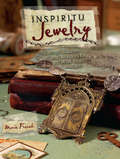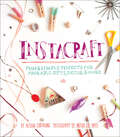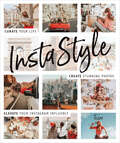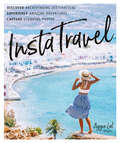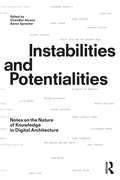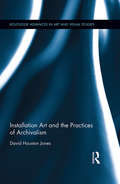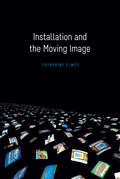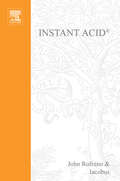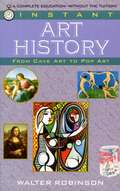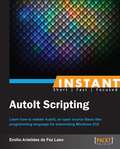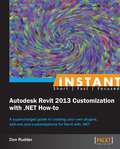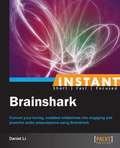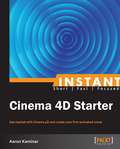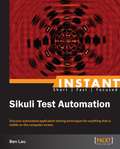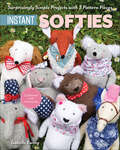- Table View
- List View
Inspiritu Jewelry: Earrings, Bracelets and Necklaces for the Mind, Body and Spirit
by Marie FrenchCreate beautiful jewelry for better wellbeingDiscover the power of creating unique pieces of adornment with the intention to heal. Inside Inspiritu you will turn pages borrowed from a dusty "prescriptions book" revealing restorative secrets of a legendary curandera-a woman healer-and will become inspired to create your own unique jewelry pieces to share with others. From creating your own clasps and jump rings to incorporating keepsakes with new elements there is much to discover here. You'll also: • Master a variety of metalworking jewelry techniques such as forging, stamping, sawing, wirework and more. • Learn the qualities instilled in specific colors and gemstones to truly target the needs of those you create jewelry for. • See how easy it is to turn new objects into ones that appear aged and where to go to find vintage treasures to use in your works. • Combine vintage elements with new materials to create striking pieces with both form and function. • Pamper yourself or others using the plentiful suggestions for restorative teas and other healing treatments.Whether you enjoy making earrings, bracelets or necklaces, start creating beautiful jewelry for the betterment of your mind, body and soul.
InstaCraft: Fun and Simple Projects for Adorable Gifts, Decor, and More
by Alison Caporimo Meera Lee PatelSUPER CUTE, SURPRISINGLY EASY Whether you're a crafting pro or newbie, this book shows how to turn five minutes, a few simple items and your own creativity into stylish, personalized stuff, including:* Brick Bookends* Berry Personalized Stationery* Faux French Lockets* Sweetheart Sugar Jars* Traveling Globes* Takeout Container Lanterns* Paint-Swatch Key Hooks* Pantone Placemats* Time Capsule Terrariums* Fond Memories Wrapping Paper* And more!
InstaStyle: Curate Your Life, Create Stunning Photos, and Elevate Your Instagram Influence
by Tezza (a.k.a. Tessa Barton)Gain Instagram followers, grow your personal brand, and influence others with your authentic personality, beautiful photography, and stunningly curated grid.Whether your passion is fitness, fashion, food, or anything in between, you can turn that passion into a business that will inspire and influence others! Instagram is the place where trends break, tastes are made, and brands are launched, and it&’s packed with insightful analytics and handy business tools that will help you elevate your social media presence to the next level. But how do you get there? InstaStyle is a must-have guide for any Instagrammer who aspires to become an influencer. You&’ll learn to create your brand, connect with others, and share the way you see the world! Tezza (@tezza) and other well-known Instagram influencers will show you how they&’ve procured their platforms, and teach you how to tell compelling visual stories that will help your build your own brand.Here is what you'll find in InstaStyle: • Beautiful imagery and easily understood guides to help you achieve your Instagram goals • Tips for creating an immediately recognizable grid aesthetic and showcasing your life, all while still remaining true to your personal brand • Expert advice and tips for creating beautiful photography, telling compelling visual stories, finding management representation, and creating successful brand engagement strategies • Inspiration and guidance from other influencers, including: @emily_luciano - fashion @travel_inhershoes - travel @thewoodenskillet - food @xandervintage - beauty @amberfillerup - family @alexajeanfitness - fitness @annemariebarton - interior design @designbyaikonik - flat lays and products
InstaTravel: Discover Breathtaking Destinations. Have Amazing Adventures.
by Aggie LalDiscover breathtaking destinations. Have amazing adventures. Capture stunning photos.Have you ever wanted to eat breakfast with a giraffe in Kenya? Or watch the sun rise from a Jacuzzi in the Philippines? Or ride a Vespa along the Amalfi Coast? Dream no more! Turn your fantasies into Instagram-worthy photos with help from Aggie Lal (@Aggie), one of the pre-eminent Instagram travel influencers.Pack your bags and grab your passport as Aggie takes you on a journey to her favorite places in the world. She'll share the best times to travel, what to do for fun in each locale, and, of course, how to recreate some of her beautiful photos. You'll also learn what you need to take with you, how to navigate cultural differences, and how to make the most of each experience.InstaStyle showed you how to create an amazing Instagram feed. Now InstaTravel can help you fill your feed with amazing photos that look just like those featured on @Aggie. Enjoy this trip to potential Instagram fame—with Aggie Lal as your tour guide.
Instabilities and Potentialities: Notes on the Nature of Knowledge in Digital Architecture
by Chandler Ahrens Aaron SprecherNow that information technologies are fully embedded into the design studio, Instabilities and Potentialities explores our post-digital culture to better understand its impact on theoretical discourse and design processes in architecture. The role of digital technologies and its ever-increasing infusion of information into the design process entails three main shifts in the way we approach architecture: its movement from an abstracted mode of codification to the formation of its image, the emergence of the informed object as a statistical model rather than a fixed entity and the increasing porosity of the architectural discipline to other fields of knowledge. Instabilities and Potentialities aims to bridge theoretical and practical approaches in digital architecture.
Installation Art and the Practices of Archivalism (Routledge Advances in Art and Visual Studies)
by David Houston JonesOn the leading edge of trauma and archival studies, this timely book engages with the recent growth in visual projects that respond to the archive, focusing in particular on installation art. It traces a line of argument from practitioners who explicitly depict the archive (Samuel Beckett, Christian Boltanski, Art & Language, Walid Raad) to those whose materials and practices are archival (Mirosław Bałka, Jean-Luc Godard, Silvia Kolbowski, Boltanski, Atom Egoyan). Jones considers in particular the widespread nostalgia for ‘archival’ media such as analogue photographs and film. He analyses the innovative strategies by which such artefacts are incorporated, examining five distinct types of archival practice: the intermedial, testimonial, personal, relational and monumentalist.
Installation and the Moving Image
by Catherine ElwesFilm and video have a double nature; they create an illusory world, a reality elsewhere and a material presence that both dramatises and demystifies the magic trick of moving pictures. Since the 1960s, artists have systematically explored filmic and televisual phenomena in the controlled environments of galleries and museums, drawing on multiple antecedents in cinema, television and the visual arts. This volume traces this lineage through architecture, painting, sculpture, performance, film history, and the ferment of counter-cultural film and video practices in the 1960s, 1970s and 1980s. Sound, an often overlooked element of installed work is given due attention, as are issues of spectatorship, incorporating the new insights offered by cognitive science. Woven into this genealogy is a discussion of the procedural, political, theoretical, and ideological positions espoused by artists, concentrating on the period from the mid-twentieth century to the present. The book, written from the perspective of a writer and practitioner, ends with a question: 'what's in it for the artist?'
Installation and the Moving Image
by Catherine ElwesFilm and video create an illusory world, a reality elsewhere, and a material presence that both dramatizes and demystifies the magic trick of moving pictures. Beginning in the 1960s, artists have explored filmic and televisual phenomena in the controlled environments of galleries and museums, drawing on multiple antecedents in cinema, television, and the visual arts. This volume traces the lineage of moving-image installation through architecture, painting, sculpture, performance, expanded cinema, film history, and countercultural film and video from the 1960s, 1970s, and 1980s.Sound is given due attention, along with the shift from analogue to digital, issues of spectatorship, and the insights of cognitive science. Woven into this genealogy is a discussion of the procedural, political, theoretical, and ideological positions espoused by artists from the mid-twentieth century to the present. Historical constructs such as Peter Gidal's structural materialism, Maya Deren's notion of vertical and horizontal time, and identity politics are reconsidered in a contemporary context and intersect with more recent thinking on representation, subjectivity, and installation art.The book is written by a critic, curator, and practitioner who was a pioneer of British video and feminist art politics in the late 1970s. Elwes writes engagingly of her encounters with works by Anthony McCall, Gillian Wearing, David Hall, and Janet Cardiff, and her narrative is informed by exchanges with other practitioners. While the book addresses the key formal, theoretical, and historical parameters of moving-image installation, it ends with a question: "What's in it for the artist?"
Instant
by Christopher Bonanos"Pictures in a minute!" In the 1950s, '60s, and '70s, Polaroid was the hottest technology company on Earth. They were an innovation machine that cranked out one irresistible product after another. It was even the company after which Steve Jobs is said to have modeled Apple, and the comparison is true. Jobs's hero, Edwin Land, Polaroid's visionary founder, turned his 1937 garage startup into a billion-dollar pop-culture phenomenon. Instant: The Story of Polaroid, a richly illustrated, behind-the-scenes look at the company, tells the tale of Land's extraordinary and beloved invention. From the introduction of Polaroid's first instant camera in 1948 to its meteoric rise and dramatic collapse into bankruptcy in the 2000s, Instant is both a cautionary tale about tech companies that lose their edge and a remarkable story of American ingenuity. Written in a breezy, accessible tone by New York magazine senior editor Chris Bonanos, this first book-length history of Polaroid also features colorful illustrations from Polaroid's history, including the company's iconic branding and marketing efforts.
Instant ACID: VASST Instant Series
by John RofranoACID Pro 5 continues to break new ground in loop-based music composition. Novices can use it for basic loop-based composition drawing on the enormous talent of the loop-based creators to assemble a song by painting loops on the timeline. Musicians can augment existing loops by recoding their own loops, or by using it to create entire tracks that don't loop.This Instant series guide uses carefully detailed screenshots and step-by-step directions to detail how you can use ACID in a concise, time-efficient way. Beginning with a review of the fundamental concepts, you get a complete guide to loop-based music including advanced looping techniques, methods to create your own loops, as well as a grab bag full of valuable tips and tricks. Beyond looping, you learn how to: customize the interface to your preferences, work with a video tracks, beatmap to remix, fix tempo drift, or create new tracks, use Groove Quantization to improve rhythmic timing, achieve an efficient workflow with the Media Manager, record digital audio and MIDI, sync ACID with other software programs, apply effects plug-ins, mix for optimal effect, and master and burn the final project.
Instant Art History: From Cave Art To Pop Art
by Walter RobinsonFrom the prehistoric cave paintings to Andy Warhol's soup cans, this lively chronicle surveys the rich history of artistic expression. INSTANT ART HISTORY examines such geniuses as Michelangelo, da Vinci, Rembrandt, Renoir, van Gogh, and the Impressionists as well as Dali, Matisse, Picasso, Kandinsky, and Lichtenstein. With INSTANT ART HISTORY you'll learn: * How Mona Lisa's smile changed forever the grim face of portrait sitters. * The differences between Analytic and Synthetic Cubism. * How the avant-garde movements of Constructivism, Dadaism, and Surrealism of the 1920s redefined how society viewed art. * How the action paintings of the Abstract Expressionists allow the viewer to "feel" a painting, not just see it.
Instant AutoIt Scripting
by Emilio Aristides LasoFilled with practical, step-by-step instructions and clear explanations for the most important and useful tasks. This is a Packt Instant How-to guide, which provides concise and clear recipes for getting started with AutoIt.Instant AutoIt Scripting Essentials How-to is for beginners who wish to know more about automation and programming, system administration developers who intent to automate/manage clusters and servers, and for computer programmers who want to control any PC to create seamless automation apps.
Instant Autodesk Revit 2013 Customization with .NET How-to
by Don RudderFilled with practical, step-by-step instructions and clear explanations for the most important and useful tasks. Get the job done and learn as you go. "Instant Autodesk Revit 2013 Customization with .NET How-to" is written in a friendly, practical style with an introductory chapter that walks through everything in detail to get you going with your very first add-on. This book is for anyone that has an interest in customizing or automating Autodesk Revit 2013. A very basic level of programming experience is assumed but not necessarily required.
Instant Boris Effects (Instant Ser.)
by Chris VadnaisBoris plug-in applications, including Graffiti, FX, and Red, permit video editors to add titling, effects, compositing, and 3D capabilities to their nonlinear editing (NLE) systems. Documentation and training materials have been notoriously lacking for these applications. Instant Boris Effects is a complete guide for novice and intermediate users of Boris Graffiti, FX, and Red applications. Beginning with an orientation to the user interface, readers learn how masks, splines, containers, and filters work. They'll learn how to apply Boris effects through their NLE, and the benefits of using them as stand-alone applications. The second section provides detailed, step-by-step instructions on building example effects that readers can incorporate into their own work - including rotoscoping effects, animating still images, text on a path, 3D extruded objects with media mapping, and clean chroma-key effects.
Instant BrainShark
by Daniel LiFilled with practical, step-by-step instructions and clear explanations for the most important and useful tasks. "Instant BrainShark" is a step-by-step guide to creating online presentations using BrainShark. The book covers digital marketing best practices alongside tips for sales conversions. The book is written in an easy-to-read style for anybody to easily pick up and get started with BrainShark.Instant BrainShark is for anyone who wants to use BrainShark to create presentations online and share them around the community. The book is also useful for developers who are looking to explore BrainShark as a possible way to market their existing presentations or podcasts.
Instant Cinema 4D Starter
by Aaron KaminarGet to grips with a new technology, understand what it is and what it can do for you, and then get to work with the most important features and tasks.This book is written in a friendly, practical style with lots of screenshots and help that will ensure you grow in confidence chapter by chapter.This book is recommended for artists that have experience in other 3D software packages, and who want to learn Cinema 4D. That being said, dedicated readers without experience in other 3D software should not be discouraged from reading this book to learn the basics of Cinema 4D as their first 3D package.
Instant DVD Workshop 2
by Mark DileoUlead DVD Workshop is DVD-authoring software designed for video professionals and enthusiasts working on the Windows platform. It permits users to import video from digital or analog sources with sophisticated MPEG capture and conversion tools and build professional looking still or motion menus using an extensive set of design tools. Instant DVD Workshop 2.0 presents carefully detailed screen shots and step-by-step directions illustrating how to use DVD Workshop software. Beginning with the proper installation of the application, it covers the full scope of functions, including managing media, importing stills and graphics, editing video, inserting audio files, creating menus, and finish authoring, with professional tips and techniques covering workflow and other topics provided along the way.
Instant Digital Audio: VASST Instant Series (Instant Ser.)
by Douglas Spotted EagleThe rapid drop in costs of digital audio recording and production tools has led to widespread adoption by "non-audio" people. Multimedia producers, including videographers and graphic designers producing for the Web and other media, need to learn the many details of producing digital audio. Hot topics include selecting and using recording hardware including microphones, headphones, and monitors; how to use postproduction-editing software; and how to deliver the finished audio in an array of media/formats.Instant Digital Audio presents digital audio principals and techniques for the non-audio specialist. Videographers and multimedia producers who are new to audio learn how to select the hardware and software that they need and how to use it. Straightforward explanations supplemented with ample screenshots and technical data address recording and production topics including microphones and relevant applications, best practices in recording audio, and how to feed audio into the computer for editing. Postproduction topics include setting up a studio, acquisition and editing techniques, filtering, and restoration.
Instant EaselJS Starter
by Fabio BiondiGet to grips with a new technology, understand what it is and what it can do for you, and then get to work with the most important features and tasks.A short and precise guide to get you started with EaselJS , helping you to create some cool applications and games. EaselJS greatly simplifies application development in HTML5 Canvas using a syntax and an architecture very similar to the ActionScript 3.0 language. As a result, Flash / Flex developers will immediately feel at home but it's very easy to learn even if you've never opened Flash in your life. The book targets Web designers, animators, Digital content producers, and Flash and Flex developers. It's assumed that you will have some experience in HTML and pure JavaScript.
Instant Encore DVD 1.5 (Instant Ser.)
by Douglas Spotted EagleCarefully detailed screen shots and step-by-step directions illustrate how to use Encore DVD software in a time-efficient way. Readers learn to harness the full scope of Encore DVD's functions, including importing and organizing content to build the DVD, using Photoshop to create menus, and finish authoring. Professional tips about workflow and other topics are also provided throughout.
Instant Love: How to Make Magic and Memories with Polaroids
by Jenifer Altman Susannah Conway Amanda GilliganWith instant film once again available, Polaroids and other instant cameras are enjoying a resurgence in popularity. This friendly and informative guide is the essential how-to book for shooting gorgeous instant pictures with personal panache and a touch of romance. Packed with tips on how to shoot with various cameras, details about the different types of film available, advice on composition and lighting techniques, plus creative projects to transform snapshots into keepsake mementos and portfolios of beautiful images for inspiration, this is the ultimate companion for capturing instant memories.
Instant Pot 3 Book Box Set: 250 Recipes and Projects, 3 Great Books, 1 Low Price!
by David Murphy Hope ComerfordThree Instant Pot Books in One Beautiful Box Set! Make the most of your Instant Pot with this collection featuring 200 recipes for everything from delicious dinners to beer to candles! The perfect gift for anyone with an Instant Pot or other multicooker, you'll be amazed at how easy it is to cook soups and stews, bake a loaf of bread, make your own lip balm, prepare homemade dog food, and so much more! Fix-It and Forget-It Instant Pot Cookbook offers 150 easy and delicious recipes from the New York Times bestselling series. Recipes include Meatballs, Chicken Cheddar Broccoli Soup, Pulled Pork, Slow Cooked Honey Garlic Chicken Thighs, and more!Instant Pot Crafts and Projects includes 50 creative ideas for fun and useful items to make for yourself or to give to family and friends. Get the kids involved and have an Instant Pot craft day! Make handmade soaps and lotion, tie dye any clothing item, whip up herb-infused olive oil, and more!Instant Pot Magic will surprise you with 50 recipes you had no idea you could make in an Instant Pot. Impress your friends with homemade kimchi, rosé marmalade, or a rustic loaf of bread! Beautifully packaged and value priced, this is a collection you'll turn to again and again.
Instant Prezi for Education How-to
by Domi SinclairFilled with practical, step-by-step instructions and clear explanations for the most important and useful tasks.This is a Packt Instant How-to guide, full of illustrative screenshots, tips, and step-by step recipes. It's a practical guide to creating impressive presentations for your students and colleagues.This book is written for those working in the education field who are looking for a way to create more engaging presentations. You do not need to have any previous knowledge of Prezi as this book starts from scratch.
Instant Sikuli Test Automation
by Ben LauGet to grips with a new technology, understand what it is and what it can do for you, and then get to work with the most important features and tasks. A concise guide written in an easy-to follow style using the Starter guide approach.This book is aimed at automation and testing professionals who want to use Sikuli to automate GUI. Some Python programming experience is assumed.
Instant Softies: Surprisingly Simple Projects with 3 Pattern Pieces
by Isabelle EwingSweet, simple softies in three easy steps Everyone can make softies with this simple three-step method perfect for complete beginners and avid crafters. Sew any of seven animals, including a bear, fox, elephant, or mouse! Plus, add accessories to bring out their unique and adorable personalities. Give your handmade stuffed animal a bow and hat for a dashing look or a scarf and bag for a cold and windy day. This is a simple craft for anyone to enjoy; the only hard part is deciding which softie to make next!. Mix and match outfits to give each softie a unique personality. Softies make lovely, thoughtful gifts and can be sewn up in a matter of hours The 3 pattern piece, 3-step system is perfect for crafters who want a project they can learn and complete, even without much experience
